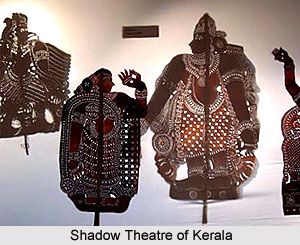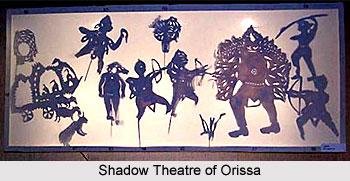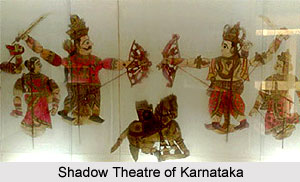 Shadow theatre is a form of performing art. This is somewhat related to puppetry or Puppet theatre. There is an important difference between the two. In puppet theatre the audience directly sees the puppets but in shadow theatre it sees only their moving shadows. These shadows are usually cast by light on a screen. The audience sits in front of the screen, while the puppeteers operate behind it. Thus the spectators and actor-manipulators are placed as if in different rooms separated by the all-important screen. This filters and modifies the action and this is almost like a primitive motion picture. The actor-manipulator is isolated from his audience, unlike the performer`s experience in live theatre. He must present a projection of his thoughts and expect the viewer to reassemble and interpret them. It is not the figure in his hands but its shadow on the screen`s other side that constitutes the dramatic image. The audience retranslates these moving pictures into actions and incidents in this fascinating and exciting experience.
Shadow theatre is a form of performing art. This is somewhat related to puppetry or Puppet theatre. There is an important difference between the two. In puppet theatre the audience directly sees the puppets but in shadow theatre it sees only their moving shadows. These shadows are usually cast by light on a screen. The audience sits in front of the screen, while the puppeteers operate behind it. Thus the spectators and actor-manipulators are placed as if in different rooms separated by the all-important screen. This filters and modifies the action and this is almost like a primitive motion picture. The actor-manipulator is isolated from his audience, unlike the performer`s experience in live theatre. He must present a projection of his thoughts and expect the viewer to reassemble and interpret them. It is not the figure in his hands but its shadow on the screen`s other side that constitutes the dramatic image. The audience retranslates these moving pictures into actions and incidents in this fascinating and exciting experience.
In the backstage between a light source and the screen, the puppeteers usually insert flat figures. They lightly press them on the screen so that the shadows are sharp. If they are not pressed on the screen their shadows become hazy. Normally, the puppet figures in shadow theatre are made of leather. Of course, they can be made from any opaque material like cardboard but leather can be used many more times without damage. The leather is carefully stencilled so that the shadows suggest the puppets clothing, jewellery, and other accoutrements. Some figures have jointed limbs which, when manipulated, show the audience beautiful moving shadows.
 India has a very long and rich tradition of shadow theatre. According to many scholars, the art originated here two millennia ago. The earliest reference appears in Cilappatikaram. This was a Tamil classic written during that time. Many Western Indologists, such as Pischel, Lueders, and Winternitz, think that the well-known Sanskrit theatre or drama Mahanataka or "Great Drama" was originally a text for shadow theatre. Subhata`s Dutangada was a play from the thirteenth century. It expressly designated as chhayanataka or shadow drama. These documents indicate that India has a continuous history of shadow theatre for about 2000 years. Possibly the form reached Southeast Asia, where it now flourishes.
India has a very long and rich tradition of shadow theatre. According to many scholars, the art originated here two millennia ago. The earliest reference appears in Cilappatikaram. This was a Tamil classic written during that time. Many Western Indologists, such as Pischel, Lueders, and Winternitz, think that the well-known Sanskrit theatre or drama Mahanataka or "Great Drama" was originally a text for shadow theatre. Subhata`s Dutangada was a play from the thirteenth century. It expressly designated as chhayanataka or shadow drama. These documents indicate that India has a continuous history of shadow theatre for about 2000 years. Possibly the form reached Southeast Asia, where it now flourishes.
Fortunately, shadow theatre traditions still exist in varying styles in peninsular India. The examples can be set as in Orissa it is called Ravana Chhaya, in Andhra Pradesh this is Tolu Bommalata, in Tamil Nadu this is Tolu Bommalattam, in Kerala this is Tolpavakuttu, etc. Some other examples can be given as in Karnataka it is named as Togalu Gombeyata, and in Maharashtra it is named as Chamdyacha Bahulye or `leather puppets`. The puppets of Orissa, Kerala, and Maharashtra cast shadows in black and white, and draw exclusively upon myths of Lord Rama for their stories. On the other hand the other three states throw spectacular multicoloured shadows. To make them coloured, the leather is first treated into translucency, and then different dyes are applied. These colour forms derive narrative material from the epic Ramayana and Mahabharata, as also other Puranic literature.
 The Maharashtrian form barely survives in the hands of one troupe in Kudal village in Ratnagiri district. This knows how to present its plays with the old figures handed down by its forefathers, but has lost the art of making these delicately-coloured group puppets and single characters with highly stylized settings. In contrast, Andhra Pradesh now has the strongest activity in shadow theatre, with more than a hundred puppeteers. Their puppets are very large, ranging from 1 to 2 m. Karnataka uses similar figures as well as some other smaller ones.
The Maharashtrian form barely survives in the hands of one troupe in Kudal village in Ratnagiri district. This knows how to present its plays with the old figures handed down by its forefathers, but has lost the art of making these delicately-coloured group puppets and single characters with highly stylized settings. In contrast, Andhra Pradesh now has the strongest activity in shadow theatre, with more than a hundred puppeteers. Their puppets are very large, ranging from 1 to 2 m. Karnataka uses similar figures as well as some other smaller ones.
All the styles have stock characters whereas many known for wit and humour. Music that is heavily dependent on local folk instrumentation plays a very important role. Traditionally, oil lamps with thick wicks provide the light source, which conveys colour shadows beautifully. Their lyricism melts in the fixed glare of gaslight or electric bulbs. Similarly, the vegetable dyes used for colouring have given way to chemicals, which have not proved as satisfying aesthetically. Shadow theatres are dying slowly because people prefer "modern entertainment" like movies and television. Governments provide financial incentive for their survival, but it is too meager. Besides, no art can thrive under doles. Unless society becomes genuinely interested in the continuation of these rare forms, they are destined to vanish sooner or later.




